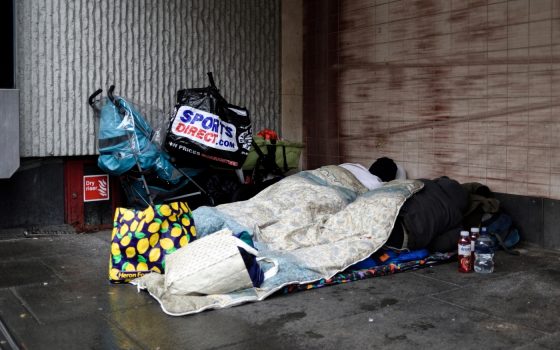Government measures fail to protect poorest from energy price surge
Poorest 10% of families in the UK set to be £420 a year worse off this spring
09 March 2022

Our ability to heat our homes has not been resilient to the last few months. And with new crises emerging, like Russia’s invasion of Ukraine, we seriously need to get to grips with energy security, ensuring that everyone can afford to come home to a warm house. The UK is not significantly dependent on Russian oil and gas, so our gas supply is not threatened. But the war is driving up gas prices again and it will have an impact for UK households both at the pump and through their energy bills. As long as we rely on volatile gas, we will be impacted by price surges and the only sustainable, long-term solution is to use less gas.
This latest spike in energy prices comes on the heels of a recent announcement from UK’s energy regulator Ofgem, which increased the energy price cap (the maximum unit tariff that suppliers can charge customers) to a whopping £1971 a year on average, an increase of £693 compared to current levels. This is a jump of 54% in household energy costs since the last revision just four months ago. Ofgem’s announcement emphasises that the rise in energy bills is largely down to an unprecedented rise in the wholesale price of natural gas, as a result of volatile global supply conditions globally coming out of the pandemic, and a colder than usual winter in 2021 eating into reserves.
This is a crisis in global fossil fuel markets, with over 80% of the jump in the price cap down to these wholesale price increases. But this fact is unfortunately unlikely to put to bed myths being peddled by a few backbench MPs who blame renewable energy and the government’s net-zero policy for the energy crisis.
The new price cap reflects the annual cost for an average household with a typical energy consumption. But this increase is distributed unequally, with the poorest households facing sharper rises than the average. As a percentage of incomes, the poorest households will see their household budget shrink by 6% (£724) in April, from the expected rise in energy bills. This is 7.5 times larger than the rise for the richest families.
Single parents, pensioners and families with one or more disabled people are likely to be hardest hit by the raw effects of this price rise (prior to any government support) as shown in figure 1. Higher bills for single parents will consume 2.5% (£647) of disposable income, a 56% larger rise compared to the average family (1.6% of disposable income). Pensioner households will see their bills rise by 2.3% (£634) of disposable income, and families with a disabled member by 2% (£682): 41% and 23% larger than the average, respectively. We are already hearing stories of pensioners skipping meals so they can afford their heating bills, and parents only switching the heating on when their children are at home. The new price cap in April will make problems like these so much worse.
Figure 1: Single parents, pensioners and families with a disabled member will be hit harder by energy price rises
In response, the chancellor has announced a slew of measures, including a £150 rebate on energy bills paid to those living in homes on council tax bands A to D this April, and a £200 loan to all families through their energy bill starting this autumn (at a total upfront cost of £8.8bn, before loan repayment). A further £300m is being put towards an increase in the warm homes discount and a small discretionary fund for local authorities to support families missing out on the council tax band payment.
In sum, these measures are too little, too late, overly complicated and poorly targeted. Let’s look at the payment based on council tax bands first. These bands are based on property valuations from three decades ago. Since then, property values have not increased at an equal rate across the country. Occupants of an average property in Kensington and Chelsea pay less in council tax than those in Selby, North Yorkshire, despite an average home in the former being 13 times more expensive than in the latter. Even without differential price rises in property values, council tax bands would still remain only a weak proxy for family incomes.
Our analysis shows that, come April, and after taking account of the full suite of policy changes — including national insurance, benefit increases and higher national minimum wage — the council tax rebate will still see the poorest families lose the largest proportion of their disposable incomes to higher energy bills (figure 2 below). The lowest income 10% of families will be around £420 worse off in annual terms, or 2.5% of disposable incomes.
Figure 2: Council tax rebate is poorly targeted with some poorer households missing out
The chancellor’s second measure is a flat £200 loan on energy bills from October, provided directly by energy suppliers. This will be clawed back from consumers through £40 instalments over the next five years. Despite analysts indicating that gas prices are set to remain high over the next two or three years, the government’s policy boldly assumes wholesale energy prices will fall considerably from next year.
Figure 3 below shows the combined effects of both the council tax band rebate, and the energy bill rebate loan across equivalised income deciles. In our modelling, we assume the £200 discount to have a direct and equal impact on reducing the price cap across all income groups. The analysis shows that taking the price cap with the two main government mitigations as a package, the net effects are still highly regressive as a proportion of income (Figure 3).The poorest 10% of households are hardly any better supported than other deciles, but these households on average spend three times more on gas and electricity, as a percentage of their income, compared to the top earners.
Figure 3: Poorest households could be worse off by nearly £400 from the price cap rise, overnight
The picture becomes only marginally better once all policy changes kicking in this April are taken into account.This includes higher national insurance for both employee and employer contributions of 1.25%, but offset by benefit payments increased to match inflation levels from last September, and the 6.6% increase in the national minimum wage. These changes will benefit low-income households, but our modelling shows that even after the energy bill support payments, the very poorest households are still proportionally worse hit than anyone else in the bottom half of all households (figure 4).
Figure 4: Everybody is left worse off, including middle-income households
The chancellor ruled out support through the social security system, arguing that millions of middle-income households need support. But this neglects the fact that many middle-income families rely on means-tested social security, particularly working tax credits and universal credit for those in work. The government’s package gets the balance wrong between targeted progressive measures and more universal ones, funnelling too much support where it is not essential and not doing enough for families that desperately need it.
To demonstrate this point, figure 5 shows how the government’s reforms compare to both Labour’s proposals and a third counterfactual package. Our counterfactual package is costed at the same level as the government’s proposals (minus the discretionary fund and the extension to the warm homes discount which we implicitly assume would remain in place). But the package relies most heavily on the existing welfare system, with an £800 per year increase to all means-tested benefits, plus a non-repayable £40 energy rebate for all households in October.
The Labour Party’s proposed package for households totals £6bn (including £3.5bn on a £400 uplift to 9.3m households and £2.5bn on VAT reduction). Both our counterfactual and Labour’s package are demonstrably more progressive across income deciles than the government’s reforms, with the same or lower overall cost. Under the government’s proposals, the poorest 10% of families would still be worse-off on average than anyone else in the bottom half of the income distribution. But concentrating more heavily on the existing means-tested benefits system could ensure that the poorest third do not get any poorer.
Figure 5: A more targeted scheme through the benefits system would have fully protected poorer households from the price cap rise
Our analysis clearly highlights the fact that the package of support announced by the government fails to really support the families facing the sharp end of energy price rises. As we have previously shown, the pandemic has already set half the country on lower incomes back by £110 while boosting the disposable incomes of the richest 5% by £3,300. Against this backdrop, the support measures should have been much better targeted. Households in the millions will instead have to rely on a small discretionary fund of £144m, managed by local authorities, if they do not qualify for the council tax rebate. Resolution Foundation estimates that 640,000 households, just in the lowest income group, could miss out on support.
The chancellor however will have another opportunity to amend his approach soon. Given the unprecedented rise in gas prices, the energy regulator is seeking to update the price cap every three months instead of the usual six. Independent analysts are already ringing alarm bells that another round of price cap changes, currently scheduled for October, could see bills rise on average to at least £2400, with some estimating a jump to over £3000 a year. Such a rise would easily negate the meagre support that the government offered to households last month. The chancellor should really step up and offer more and better targeted financial support for families.
When considering longer term solutions, upgrading the UK’s draughty leaky homes can lock in savings for years to come. When it comes to energy efficiency, an average household living in a home with an energy performance certificate (EPC) rating of C could pay £560 less a year in energy bills than an average household living in a home on band D or below. Energy efficient homes are the most protected against current or future gas price volatility.
The government is reportedly looking at spending at least £12bn on renovating and improving the Houses of Parliament and Whitehall buildings over the coming years. Based on the average costs per property from the only other mass retrofitting programme (the Energy Companies Obligation programme) and after adjusting for inflation, we estimate that £12bn spent today on retrofitting people’s homes would lift 4.4m homes to higher efficiency standards. In April 2022 terms, this would realise savings on energy bills starting at £345 per family and potentially rising to £740, depending on the type of household and its energy efficiency
As we have shown above, the government’s current support package is insufficient and poorly targeted. The chancellor should, as a minimum, boost benefits to those on universal credit at the upcoming budget alongside a suite of other measures such as taking environmental levies off energy bills and shifting them on to general taxation, a windfall tax on energy production firms and significantly enhancing financial support delivered via local authorities.
The ultimate solution however is in weaning ourselves off gas and the cheapest, most effective way of achieving this is through a Great Homes Upgrade — a large-scale, UK-wide programme of upgrading our leaky, inefficient homes. We want the government to commit to bring every home in the UK up to a good standard by 2030 — that means upgrading 7m homes by 2025 and 19m by 2030. A great homes upgrade means that everyone can make sure their home is well-insulated and heated by clean, green energy — no matter how much money we have.
Image: iStock
Campaigns Great Homes Upgrade
Topics Climate change Environment Housing & land Social security






